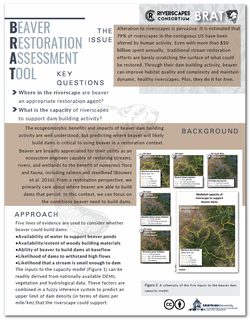Note: pyBRAT v 3.1.00 has been superseded by sqlBRAT. These pages will be left up for reference for old ArcPY ArcGIS 10.X users and for documentation purposes. We donot advise users running pyBRAT. Please check Data Exchange for avaialblity of sqlBRAT runs in your area first. sqlBRAT is run in CodeSpaces or CyberCastor and not something most users run themselves. See this Knowledge Base Article for more information.
About
 Welcome to the pyBRAT website. The Beaver Restoration Assessment Tool (BRAT) is planning tool intended to help researchers, restoration practitioners and resource managers assess the potential for beaver as a stream conservation and restoration agent over large regions and watersheds. At the heart of BRAT is a capacity model, which estimates the upper limit of dam density (dams per kilometer) for individual stream reaches throughout a drainage network. We focus on predicting where beavers could build dams and to what extent (as opposed to the more general case of where beaver could make a living), because it is the dam building activity they do as ecosystem engineers, which we are typically most interested in.
Welcome to the pyBRAT website. The Beaver Restoration Assessment Tool (BRAT) is planning tool intended to help researchers, restoration practitioners and resource managers assess the potential for beaver as a stream conservation and restoration agent over large regions and watersheds. At the heart of BRAT is a capacity model, which estimates the upper limit of dam density (dams per kilometer) for individual stream reaches throughout a drainage network. We focus on predicting where beavers could build dams and to what extent (as opposed to the more general case of where beaver could make a living), because it is the dam building activity they do as ecosystem engineers, which we are typically most interested in.

The BRAT model can be run with freely available national data sets, or with higher resolution data, and is used to identify opportunities, potential risks and constraints through a mix of assessment of existing resources and proximity to infrasturcture). The backbone to BRAT are spatial models that predict the capacity of riverscapes to support dam-building activity by beaver. By combining capacity and potential risk, researchers and resource managers have the information necessary to determine where and at what level reintroduction of beaver and/or conservation is appropriate.
A Riverscapes Network Model
 BRAT 1.x through 3.x were developed by the Wheaton ET-AL lab at Utah State University. The Riverscapes Consoritum has given pyBRAT 3.1.0 a operational grade ranking (see grading here)
BRAT 1.x through 3.x were developed by the Wheaton ET-AL lab at Utah State University. The Riverscapes Consoritum has given pyBRAT 3.1.0 a operational grade ranking (see grading here)
BRAT is one of a suite of network models that are part of the Riverscapes Consortium’s suite of open-source tools for better understanding, studying and managing our riverscapes.
Learn More About Beaver
For more information on beaver and workshops we teach through Utah State University’s Restoration Consortium and the Department of Watershed Sciences, see here.



